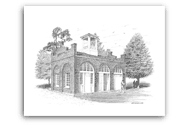John
Brown's Fort
Harpers Ferry, West Virginia
#NC-16730-OP - Notecards
Also available in Assortment Pack #AST-800
Since its
construction in 1848, John Brown's Fort has been vandalized, dismantled,
and moved four times all because of its fame as John Brown's stronghold.
Originally a U.S. Armory fire-engine house, the building was the
site of the capture of the famous abolitionist, John Brown, after
his 1859 raid on Harpers Ferry.
Ransacked
by souvenir-hunting Union and Confederate soldiers and travelers
in the early 1860's, transported to the Chicago Exposition in
1891, later purchased by Storer College and moved to campus, the
building was finally relocated close to its original site by the
National Park Service in 1968.
Text
© 1993 Dianne Harrah, Drawing © 1993 Bill Harrah
|

|
|
Copyright
Notice
Drawings Copyright © 1992-2010 Bill Harrah, Wolf Run Studio (SM), All Rights
Reserved. Wolf Run Studio is a service mark of Bill Harrah and has been in continuous use since 1992. All of the images on this website are in tangible form and are fully
copyrighted. Each has an invisible digital identification which is traceable
through the Digimarc Corporation. Viewers of the Wolf Run Studio website are
allowed to browse and print out images for personal, non-commercial use only.
You may not distribute copies of images or image files to anyone else for any
reason. Images may not be reproduced or used in any form or any manner, or displayed
on any website without the express written consent of Bill
Harrah.
Text Copyright
© 1992-2010
Terry White or
Dianne Harrah. Text on this website is used with permission from the authors.
Viewers of the Wolf Run Studio website are allowed to browse and print out text
for personal, non-commercial use only. Text may not be reproduced or used in any
form or any manner without the express written consent of the authors.
Information
Accuracy
The information for the written description of each location has been carefully
researched by the authors and is believed to be accurate. New findings, however,
could make some information out-of-date. If you are a professional historian,
archaeologist, or architect, and have new information that you are willing to
share, please contact
Dianne Harrah
.
|



